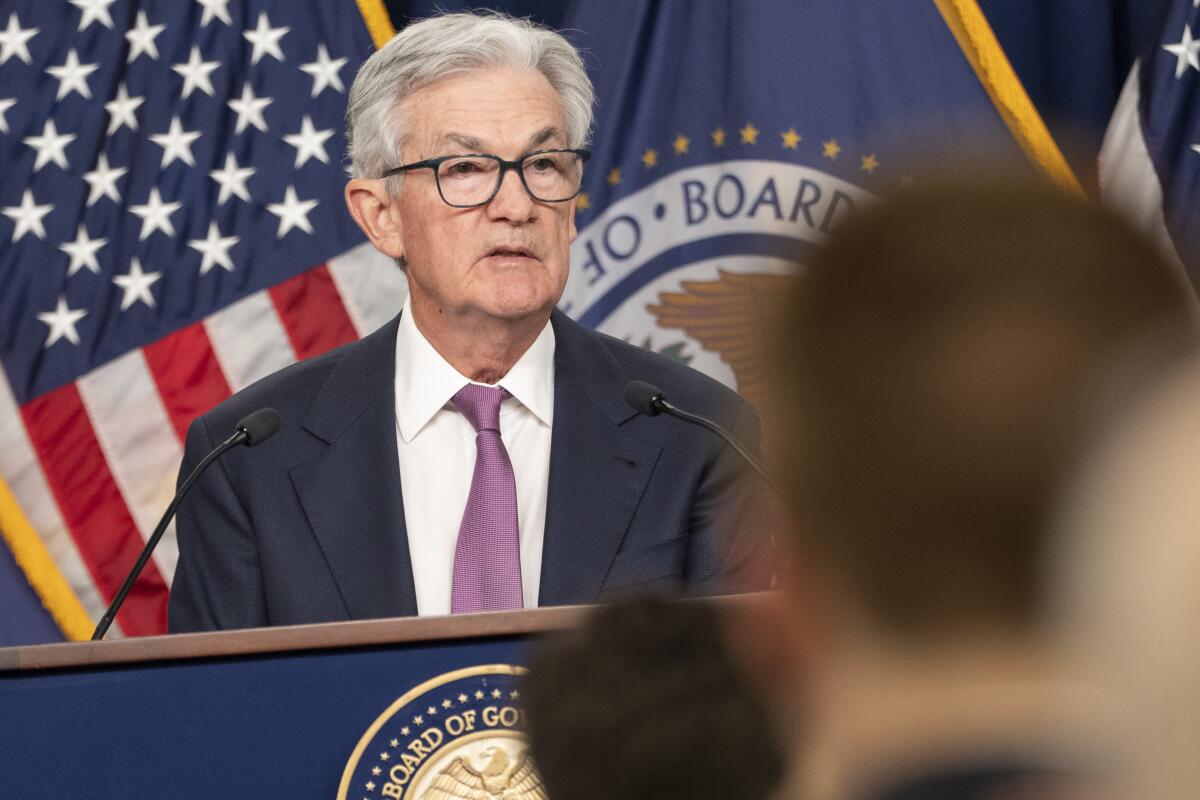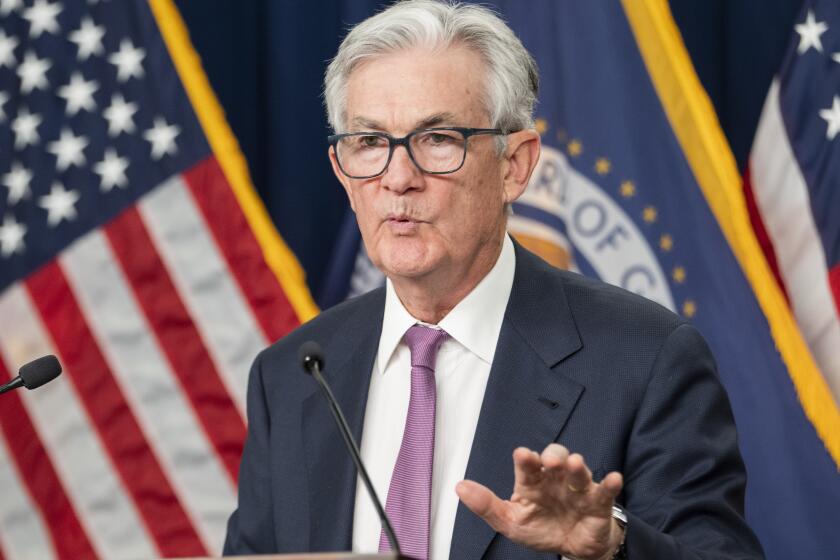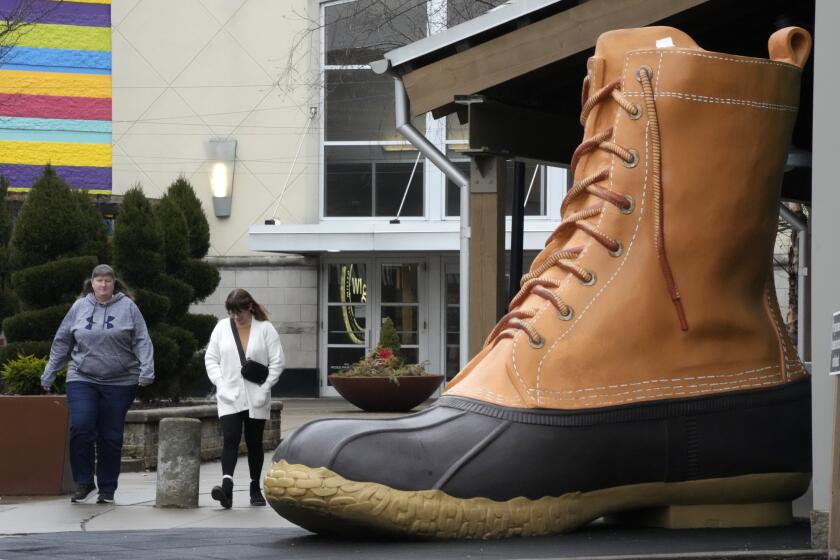Almost all Fed officials backed quarter-point interest rate hike, minutes show

- Share via
Nearly all Federal Reserve policymakers agreed earlier this month to slow the pace of their rate increases to a quarter of a point, with only “a few” supporting a larger half-point hike.
The minutes from the Fed’s Jan. 31-Feb. 1 meeting said most of the officials supported the quarter-point hike because a slower pace “would better allow them to assess the economy’s progress” toward reducing inflation to their 2% target.
The increase raised the Fed’s benchmark rate to a range of 4.5% to 4.75%, the highest in 15 years. It followed a half-point rate increase in December and four three-quarter-point hikes before that.
The central bank’s rate hikes typically lead to more expensive mortgages, auto loans, credit card borrowing and business lending. Last year’s three-quarter-point rate hikes marked the fastest pace of credit tightening in four decades.
At the meeting, Fed officials also unanimously agreed that “ongoing increases” in the Fed’s key rate “would be appropriate,” which points to additional hikes in the next two meetings, at least.
Overall, the minutes showed that the Fed’s policymakers emphasized their determination to keep rates high to curb high inflation even as they welcomed a slowdown since the fall.
In his first remarks since last week’s blockbuster jobs report, Fed Chair Jerome Powell said he expects a ‘significant decline’ in inflation — but also further rate hikes — in 2023.
The broad consensus among the central bank officials to continue raising rates is notable, economists said. At the time of their meeting early this month, most government data were suggesting that the economy was cooling and that inflation was steadily slowing.
More recent data, though, have hinted at a potential resurgence of growth as well as sustained inflation pressures. In response, Fed officials may signal when they next meet in March that they’re considering additional rate hikes and the prospect of keeping rates high long after they have stopped raising them.
Omair Sharif, president of Inflation Insights, said he thinks the Fed will forecast more rate hikes at next month’s meeting, to a range of 5.5% to 5.75%, a half-point higher than the policymakers had projected in December.
Both Loretta Mester, president of the Federal Reserve Bank of Cleveland, and James Bullard, president of the St. Louis Fed, said last week that they had supported half-point increases in the Fed’s key rate at the Feb. 1 meeting. The minutes said “a few” officials supported a larger increase. This suggests that one or two more officials on the central bank’s 19-member rate-setting committee were in Mester and Bullard’s camp. The Fed does not disclose how each policymaker voted at its rate-setting meetings.
Still, the minutes’ emphasis on widespread support for a quarter-point increase suggests that the Fed may continue to raise rates by the smaller increment despite a string of robust economic data. Last week, Thomas Barkin, president of the Richmond Fed, reiterated his support for quarter-point hikes at future meetings, even after new government figures showed the outlook for inflation becoming more worrisome.
At a news conference Feb. 1, after the meeting, Chair Jerome H. Powell stressed that inflation, although still too high, was gradually cooling. He also suggested that it was still possible the Fed could quell inflation without raising rates so high as to cause widespread layoffs and a deep recession.
“The disinflationary process has started,” Powell said of the steady slowdown in year-over-year inflation from a peak of 9.1% in June to 6.5% in December.
Since then, a succession of economic reports has pointed to a still-robust economy despite the Fed’s eight rate hikes over the last year. Hiring has accelerated, retail sales have rebounded and revised figures show that inflation pressures remain high and might require more Fed rate hikes than many had assumed.
Last week, a government report showed that consumer price inflation rose faster than expected from December to January, and the year-over-year figure barely slowed last month, to 6.4%.
In the last three months, so-called core prices, which exclude volatile food and energy costs, have risen at a 4.6% annual rate. That is below the year-over-year number and suggests that more declines are coming. But that figure is up from 4.3% in December.
America’s consumers rebounded last month from a weak holiday shopping season by boosting their spending at stores and restaurants at the fastest pace in almost two years.
With the economy now looking stronger and inflation more persistent, economists expect the Fed to raise its key rate higher this year than previously projected. Many now expect the central bank to boost its benchmark short-term rate to a range of 5.25% to 5.5%.
That would be three-quarters of a point higher than its current level and a quarter-point higher than the Fed had projected in December. The prospect of higher borrowing rates for companies and individuals has roiled financial markets, with stock prices falling and bond yields rising sharply this month.
More to Read
Inside the business of entertainment
The Wide Shot brings you news, analysis and insights on everything from streaming wars to production — and what it all means for the future.
You may occasionally receive promotional content from the Los Angeles Times.












